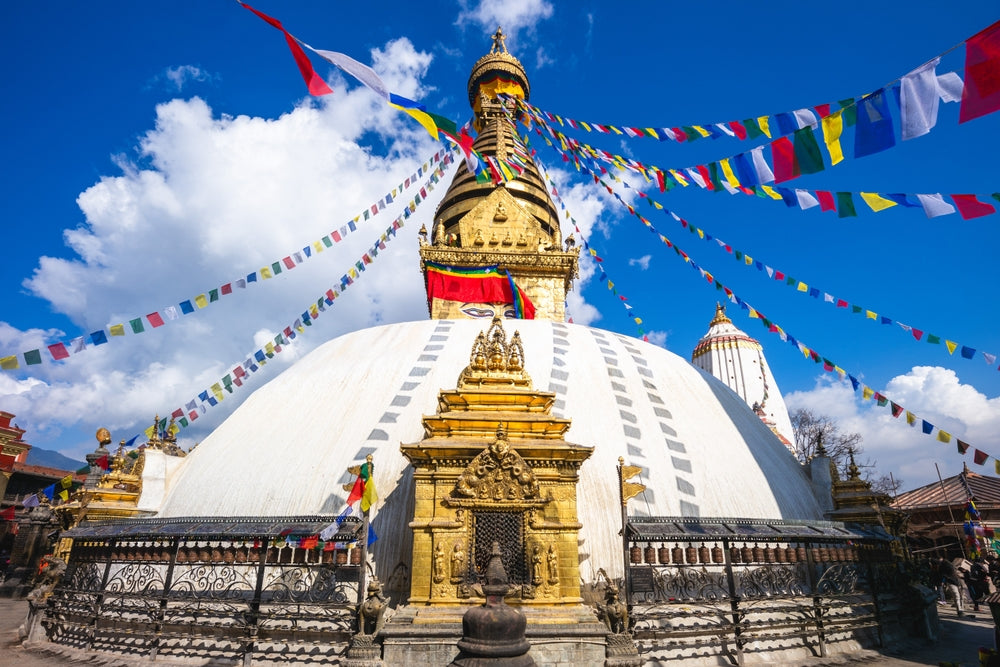
The Monkey Temple of Kathmandu
Share
Perched atop a forested hill on the western edge of Nepal’s Kathmandu Valley, the Swayambhunath Stupa—more affectionately known as the Monkey Temple—rises above the city like a timeless guardian. A swirling blend of incense, fluttering prayer flags, mischievous monkeys, and sacred chants, the temple is one of the oldest and most revered religious sites in Nepal. And despite the chaos, or perhaps because of it, it’s a place that leaves a lasting imprint on everyone who visits.

A Stairway to Enlightenment (and Mischief)
Reaching the Monkey Temple is a pilgrimage in itself. A steep staircase of 365 stone steps winds its way up the hill, flanked by prayer wheels, ancient statues, and curious monkeys swinging from branches or snatching snacks from unsuspecting tourists. It’s not just a physical climb—it’s a spiritual ascent. As you rise, so does your awareness, each step lifting you above the din of city life and into a space that feels otherworldly.
At the summit, the golden spire of Swayambhunath greets you, its iconic Buddha eyes watching in all four cardinal directions—wise, serene, and all-seeing. Below them, a third eye gazes into the soul, a reminder of the deep spiritual symbolism the stupa holds.

A Site of Sacred Origin
According to ancient legends, the Kathmandu Valley was once a vast lake, and a lotus grew from its center. When the bodhisattva Manjushri drained the lake to make the land habitable, the lotus settled atop this hill, and the stupa was built in its place. Swayambhu, meaning “self-existent,” is believed to have emerged spontaneously, making the site sacred long before temples or cities ever existed.
Today, Swayambhunath is a shared sanctuary for Buddhists and Hindus alike, where both traditions weave together in ritual, architecture, and symbolism. Butter lamps flicker in honor of departed souls, while devotees spin prayer wheels and circle the stupa clockwise in meditative reverence.

The Monkeys: Guardians or Tricksters?
Of course, no visit to the Monkey Temple is complete without mentioning its infamous residents—the rhesus macaques. They are sacred, playful, and sometimes a bit bold. Local lore says they were born from the lice in Manjushri’s hair, making them divine by origin (though you might question their holiness after watching one steal someone’s sunglasses or banana).
Still, there’s something poetic about their presence. They add a layer of wild unpredictability to the sacred atmosphere—a reminder that nature and spirit are intertwined, and that reverence doesn’t always have to be quiet.

Kathmandu at Your Feet
From the hilltop, Kathmandu unfurls below in a breathtaking panorama. The sprawl of rooftops, temple tops, and distant mountains becomes a living, breathing tapestry. It’s a place to pause, to reflect, to feel small and infinite all at once.
Tourists snap photos, monks chant in rhythmic tones, and the scent of incense mixes with cool Himalayan breezes. It’s a sensory overload that somehow feels calming—like stepping into a realm where contradictions coexist and beauty lives in the balance.

Final Thoughts
The Monkey Temple is more than a monument. It’s a living symbol of Nepal’s resilience, spirituality, and humor. It’s a place where sacred meets silly, where monkeys sit beside monks, and where history whispers through every prayer flag.
For the traveler, Swayambhunath offers more than stunning views or cultural insight—it offers a moment of perspective. Amidst the chaos of life, the monkeys remind us to let go. The stupa reminds us to look inward. And the city below reminds us that beauty is often found in complexity.
So climb the steps, watch your snacks, and let the Monkey Temple show you what it means to find peace in the middle of wildness.

